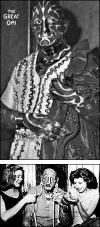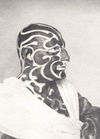Omi
| Omi | |
|---|---|

| |
| Birth Date | 1892 |
| Birth Place | |
| Death Date | 1969 |
| Occupation | performer |
| Website | none |
Horace Ridler (1892 - 1969), also known as The Great Omi, "Omi the Great", and "The Zebra Man", thanks to his astounding physical transformation.
Biography
The exact details of his story have been somewhat obscured and often exaggerated (intentionally) by Omi and those writing about him. It is generally accepted that he was born into a family that was relatively well-to-do and provided him with great opportunity — including a personal tutor who was allegedly a former circus clown. He is believed to have been well educated and to have received a degree with honors from Oxford or Cambridge. Other accounts have him foregoing university for a military career, but then resigning his commission after the death of his father and squandering his inheritance. In WWI, he enlisted and served with desert mountain corps, was decorated for gallantry, and attained the rank of major. Unable to support himself after the war solely from his pension, he struck upon the idea of becoming a show attraction.
In 1922, Omi began to get tattooed in the usual pictorial (flash) fashion. However, this was decades past the 'golden age' of the tattooed attractions in the mid to late 1800's. Many shows of this time had congresses of tattooed attractions and some even charged them to be part of the show by collecting a percentage of their photo and pitch-item sales. Omi soon realized that his tattooing was not going to be enough to support him as an attraction. As a result, he came up with a new plan to differentiate himself from the other tattooed men on the market. The year varies as much as 1927-1934 by source, but Omi contacted the self-styled 'King of Tattooists' George Burchett, and convinced him to cover his old tattoos with broad stripes and patterns that would even include his face and scalp (careful examination of photographs showing his exposed forearms reveal some of his old work still viewable in the negative space). The tattooing was said to have required over five hundred sittings from June to December. Omi boasted paying $10,000 for the work but Burchett reported the cost to be more like $3,000 and claimed that he was never fully paid. There is also some question of whether or not the design was, in fact, full body. Viewers in 1941 reported that the lower torso and legs were tattooed but still with the more common pictorial (flash) designs of other tattooed attractions. In addition to his tattooing, Omi had his teeth filed to points and stretched piercings in his septum and earlobes.
Like most tattooed attractions, Omi's act consisted of fanciful tales about his body modification. Stories of abduction in far off countries were common and Omi frequently claimed that he had been captured and tortured via tattooing in New Guinea. While his story was hardly plausible, lack of popular knowledge of far off lands and the unusual design of his tattoos and other modifications made him a smash success while others struggled. Omi successfully toured most of the western world and was a star attraction with Ringling Brothers and Ripley's Believe It or Not. He was the longest running star of Ripley's Broadway Theater appearing nine or ten times a day for 1600 show days. His wife often traveled and appeared with him as 'Omette' — she was not tattooed but simply introduced him to the stage.
At the start of WWII, Omi attempted to return to military service but was well beyond service age and was deemed too strange. He spent the war supporting Allied efforts by promoting sales of war bonds. In 1950, Omi retired to Sussex with Omette where they lived quietly until his passing in 1969.
Omi continues to be an inspiration to many tattoo fans and artists today. His images and memorabilia are highly valued and collected around the world.
Selected References
- Freak Show by Robert Bogdan
- "The Great Omi" by Judy Tuttle in Lyle & Judy Tuttle's Tattoo Historian
